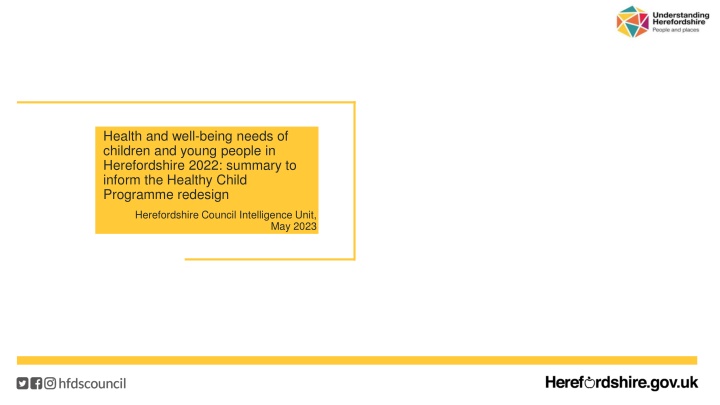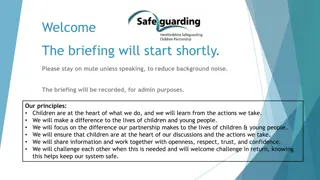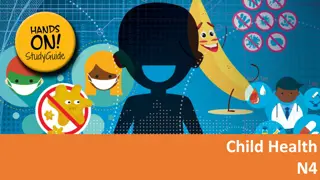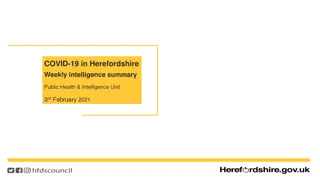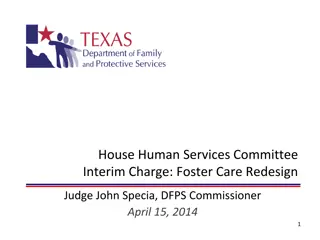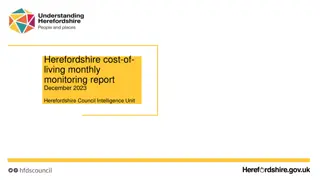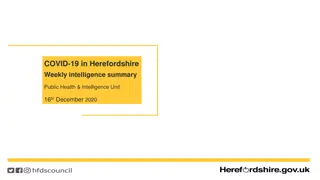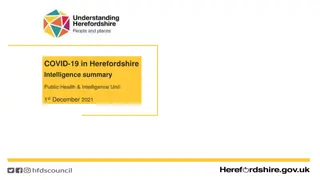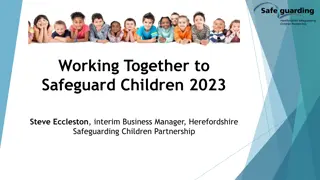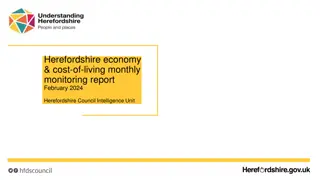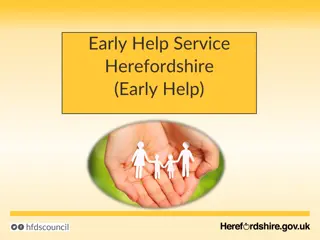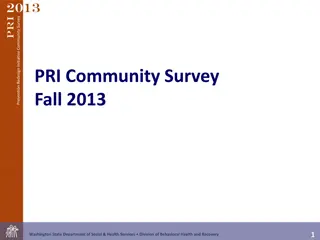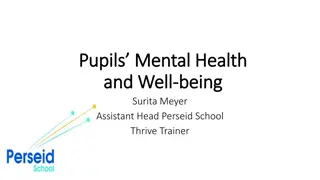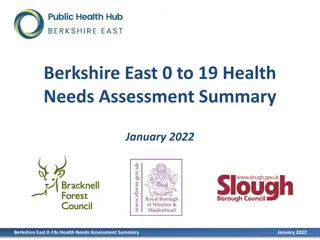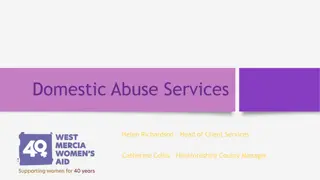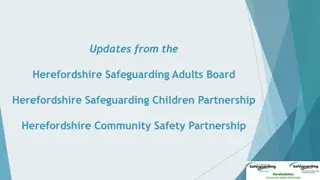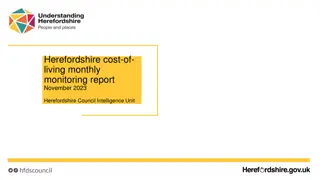Health and Well-being Needs of Children in Herefordshire: Summary for Healthy Child Programme Redesign
Analyzing the health and well-being needs of children and young people in Herefordshire for the Healthy Child Programme redesign, the report focuses on key findings and areas of impact such as home environment, child development, mental well-being, and vulnerable groups. The analysis excludes service provision assessments and specialist services, aiming to inform future plans by understanding universal targeted approaches that can have the most impact.
Download Presentation

Please find below an Image/Link to download the presentation.
The content on the website is provided AS IS for your information and personal use only. It may not be sold, licensed, or shared on other websites without obtaining consent from the author.If you encounter any issues during the download, it is possible that the publisher has removed the file from their server.
You are allowed to download the files provided on this website for personal or commercial use, subject to the condition that they are used lawfully. All files are the property of their respective owners.
The content on the website is provided AS IS for your information and personal use only. It may not be sold, licensed, or shared on other websites without obtaining consent from the author.
E N D
Presentation Transcript
Health and well-being needs of children and young people in Herefordshire 2022: summary to inform the Healthy Child Programme redesign Herefordshire Council Intelligence Unit, May 2023
Contents 1. Introduction Background Topics covered in the analysis Herefordshire in context 3. Insights for the Healthy Child Programme High impact areas for school nursing and health visiting services Key findings mapped to high impact areas: early years Key findings mapped to high impact areas: school age Key considerations for the Healthy Child Programme in Herefordshire 2. Summary of needs analysis Common themes Home and family environment Child development and educational outcomes Young adults Physical health Mental well-being Vulnerable groups Risk factors: interconnected and compounding vulnerabilities 4. More information If you need help to understand this document, or would like it in another format or language, please contact us on 01432 261944 or e-mail researchteam@herefordshire.gov.uk researchteam@herefordshire.gov.uk 2
Background Analysis scoped to inform the recommissioning of Healthy Child Programme, but Designed to be broader: profile of general health and well-being needs of children and young people (CYP) in Herefordshire, with particular focus on aspects where a universal targeted approach could have most impact. groups of CYP at risk of poorer outcomes / inequalities because of circumstances or characteristics that they share. Excluded from scope: assessment of any existing service provision or reviews of best practice elsewhere. needs for specialist services, but these have been considered in the context of opportunities for preventative services to reduce demand. Hope that it will provide insights across the system to inform future plans Note that the analytical work took place during the summer and autumn of 2022, with findings presented in November 2022. 4
Topics covered in the analysis 1. Context Demographics Place Parenting, family and the home environment 2. Health and well-being Birth and early years Child development: readiness for school and life Lifestyles Behaviours and risk taking Safe environments Mental health and well-being Health care and managing conditions 3. Vulnerable groups: children and young people who are / have Disadvantaged / in receipt of free school meals Special Educational Needs and Disabilities (SEN) / Educational Health Care Plan (EHCP) Gypsy Roma and Traveller (GRT) Other non white British backgrounds Refugees LGBTQI+ Military families Young carers Known to social services and care leavers Persistently absent from school Electively home educated or not receiving formal education. Not in Education, Employment or Training (NEET) Young parents Youth offenders 4. Needs for intervention Other services where demand could provide insight into opportunities for primary prevention E.g. Safeguarding, Early Help, health services. 5
Herefordshire: the context Herefordshire: the context
Common themes across all topics Overall, Herefordshire is a good place for its 37,200* under 20 year-olds to live. There are relatively low levels of poverty and deprivation, and the majority of children and young people are happy. Double edged sword of rurality: access to the benefits of the natural environment vs barriers to accessing facilities; underlying factor in low wage economy and social mobility cold spot for disadvantaged children. The headline figures mask some important minorities of children and young people, who are at the biggest risk of poor outcomes. Including those with additional needs; exposed to family and behavioural risks; or with experience of the care system. The Covid-19 pandemic disrupted two years of children s development: social contact, education, experiences. Lasting impacts aren t yet known, but it has undoubtedly widened pre-existing, deep-rooted inequalities, including for disadvantaged children and those living in deprived areas. There are some significant risks to consider for the future most immediately the cost of living crisis and the longer-term impact of the environmental emergency. With rising obesity levels, the baseline health of children and young people is also a concern for their future mental and physical wellbeing. Interconnections between risk factors and inter-generational factors * Note change from earlier versions which stated 39,400. This reduction is due to downward revisions in official population estimates following the 2021 Census
Home and family environment Cost of living crisis immediate threat to wellbeing of most disadvantaged children in particular and uncertain how many more will fall into poverty in the near future. Around 4,750 families with children claiming Universal Credit in May 2022. Official definitions won t show the full picture in current situation. Cold homes resulting from the fuel poverty affecting 14,000 (17%) of households even before the current crisis (2020) and the county s stock of old houses pose risks to children s health which can lead to missed education and long-term conditions. Family risk factors pandemic increased exposure to the toxic trio of parental substance misuse, mental ill-health and domestic violence. Domestic violence was observed in 59% of the 1,500 social care assessments undertaken in 2020/21, and around 40% of all risks identified at least one of the toxic trio 9
Child development and educational outcomes But areas of concern: Language disparities are evident by age 2 and are clearly having an impact by the time children get to school (OHID) - overall development levels at 2-2 dropped - fewer are ready for school - Good Level of Development at end Reception fell Impact of Covid-19on all children who experienced pandemic. - relatively high and increasing proportion of pupils have social, emotional and mental health needs (3.5% in 2021) - social-emotional skills at age 2-2 fell significantly in 20/21: even higher need in coming years? - development at 2-2 lower in communication skills than other domains (although still ~90%). In schools, 15% of children with EHCPs have speech, language and communication needs (in line with national 17%). Increasing needs related to social and emotional and speech, language and communication skills Overall early years development is good and ultimately children do relatively well at school. Outcomes for the increasing number of children with the highest level of additional need, who require Education Health and Care Plans - Numbers of children with Education Health and Care Plans (EHCPs) continue to rise; 910 in 2021/22 (3.8%) - In general these children don t do very well throughout school compared to their peers nationally Disadvantaged children Children from poorer backgrounds are more at risk of poorer development and the evidence shows that differences by social background emerge early in life. - more likely to have been affected by pandemic - on top of signs of an already widening gap as they start school - seem to fall further behind as they go through school in Herefordshire. - leaving school in a social mobility cold spot , dominated by a low wage economy. (OHID) 10
Young adults The majority (52%) of 16 to 19 year olds live in rural areas in Herefordshire, however, South Hereford city has a much younger profile than the county as a whole, with relatively high proportions of young adults and young children. 7,300 aged 16 to 19 years old Impact of alcohol Females under 18 more likely to be admitted to hospital due to alcohol than nationally and anywhere else in West Midlands. In 2021, 28% of Year 10s had drunk alcohol the week before , and were more likely to engage in other risky behaviours that those who hadn t. Increasing rates of hospital admission due to unintentional and deliberate injuries in young people aged 15 to 24 (especially amongst girls): 220 admissions in 2020/21 was the highest rate in the region. Sexual health Almost all Year 10s know how to stay safe, but concerning proportions of sexually active teens always use protection (only 38% of Y10/11) and only 25% know where to go for more advice. Road safety Although small in absolute terms (~25 a year), relatively high rates of children and young people are hurt as a result of an accident whilst in a car. In particular, the rate of 15 to 24 year-olds killed or seriously injured. 11
Physical health Some aspects of maternal health are of concern. In 2020/21 12% were smokers at time of delivery and over half were overweight. Infant mortality, particularly under 28 days, has been rising and in 2018/20 was amongst the highest in England. Maternal health is a key risk factor, as is prematurity the latter has risen over the same period. An in-depth review is underway. Oral health 1 in 3 five year-olds had visible signs of tooth decay in 2018/19 a figure that hasn t changed for over a decade, is consistently higher than England s, and compares unfavourably even with other unflouridated areas. Half of children in summer 2021 said they d seen a dentist that school year. Children s health issues to watch, which may present opportunities for doing things differently: Take-up of childhood vaccines is better than nationally, but coverage for those offered at age 2 and 3y 4m have fallen since 2015-17 and been below 95% target for several years Sustained rise in A&E attendances since spring 2021, driven by under 5s (>400 a month). Small numbers, but higher than national rates of emergency admissions for under 5s due to falls, specifically from furniture, and poisoning, specifically from medicines. Relatively high rate of admissions due to epilepsy (under 10s): 25 admissions in 2020/21, highest rate in region and amongst comparators Excess weight Already concerning situation exacerbated by Covid-19. In 2021, 39% of Year 6s were overweight up from 32% the year before. Obesity rates almost double between Reception and Y6, and children in the most deprived areas are more likely to be obese. Opportunities to increase physical activity (in 2021 a third did every day last week ) and healthy eating (only a fifth had 5+ portions of fruit and veg yesterday ). 12
Mental well-being Of children and young people: Although most are happy, a large minority have low mental well-being scores (25% primary and 48% older) and worry or anxiety affects most (75% of secondary). One third of pupils afraid to go to school at least sometimes because of bullying, and Y10s were more likely to have been bullied in 2021 than in the wider sample. Of parents: Already a big risk for the well-being of our children (as identified in 2018 needs assessment), exacerbated for many during the pandemic, and the cost-of-living crisis will make things worse. In 2020/21, mental health support for a family member was identified in 73% of new Early Help cases, and parental mental ill-health observed in 29% of social care assessments. Building resilience in children and young people can have life-long protective benefits. Fewer than had high resilience scores in 2021. Emotional wellbeing and resilience is a particular concern for secondary pupils. 13
Vulnerable groups Around 50 Afghan or Syrian refugee children have arrived in Herefordshire since 2018; more recently 300 Ukrainian children between May and August 2022 and the volatility of the situation means that the future is uncertain. Relatively high rate of pupils are identified as having SEND, with increasing numbers with higher levels of additional need: 3,500 currently receiving SEN support and 910 with an Educational Health Care Plan (EHCP). The most common primary need, of 820 pupils, is social, emotional and mental health . The majority (60%) of pupils with a statement or EHCP are in mainstream schools. Lower mental well-being and higher risk of bullying. Higher than expected numbers of children in care means that relatively large numbers will have experience of the care system and the associated risks to their life chances (mental health, education, employment, crime). Emotional wellbeing was a cause for concern in half of LAC in 2020/21 one of the highest in England (national 37%). 300 children in Care in 2021, and another 330 Care Leavers (aged 16 to 25). Gypsy Roma Travellers are an important ethnic minority in the county, with around 200 children known to be in Herefordshire schools. The GRT community face some of the most severe health inequalities and poor life outcomes. The county has a strong military connection, and the council is a member of the Herefordshire Armed Forces Covenant Partnership. At least 1,100 Service children attended Herefordshire schools in 2020/21. 14
Risk factors: interconnected & compounding vulnerabilities Many risk factors to wellbeing are linked to each other, and experiencing some can lead to others compounding their effects. Not only can early preventative action to address these multiple complex vulnerabilities improve young people s lives, it also has clear cost benefits in terms of changing their trajectory before they need intensive interventions across many services.
Inequalities in Herefordshire Note: In addition, some of the vulnerable groups identified on the previous slide often face multiple and compounding inequalities where appropriate, these are described in more detail in the full report. Poverty 16
3. Insights for the Healthy Child Programme 0 to 19 Public Health Service 17
High Impact areas for school nursing and health visiting services The government identifies six High Impact Areas for early years and six for school age years. They describe areas where public health nursing services can have a significant impact on health and wellbeing, improving outcomes for children, young people, families and communities. The images here list the areas and how they relate to the four overarching aims for each age group (as listed in the purple circles). They are designed to support local commissioners and providers to deliver the Healthy Child Programme effectively and efficiently, ensuring the safety and individual needs of children and families are central to the service model. Find out more about the High Impact Areas on the GOV.UK website The next two pages show the key findings of the needs analysis described earlier, mapped to the high impact areas
Key findings mapped to high impact areas for early years (0-5) 1. Supporting transition to Parenthood 2. Supporting maternal & family mental health 3. Supporting breastfeeding Rates are consistently high: 83% breastfeeding at birth. Smoking in pregnancy high (12%), over 50% of pregnant women overweight, infant mortality high. Family mental health worsened during the pandemic & likely to deteriorate further with cost-of-living crisis. Good access to maternity care (booking in) and newborn screening. But initiation much lower amongst mothers under 21 and those from deprived areas. Anecdotal evidence from clinicians of increased demand for perinatal mental health services. Consistently low proportion of families have a New Birth Visit within 14 days compared to England. Higher breastfeeding rates than elsewhere, but almost half of babies aren t breastfed after two months. Mental health support for family member identified in 73% of Early Help cases & parental mental ill-health observed in 29% of social care assessments. Low and falling numbers of teenage pregnancies. 6. Supporting health, wellbeing and development. Ready to learn, narrowing the word gap 4,900 CYP estimated to be living with a parent with a diagnosed mental health condition. First Steps programme has improved outcomes around budgeting, breast-feeding, safer sleeping and access to dental health information. 5. Improving health literacy: managing minor illnesses & reducing accidents. Children s health issues to watch, which may present opportunities for doing things differently Overall early years development is good, but areas of concern. 4. Supporting healthy weight & nutrition (covered in 6 and 12 month Health Visitor checks) Development levels dropped during the pandemic and fewer children are school ready . Take-up of routine vaccines better than nationally, but coverage has fallen recently and is below target. Disadvantaged children: more likely to have been with affected by pandemic. Already signs of the gap widening as they go through school before Covid. Consistently high coverage for 6 to 8 week reviews but deteriorates more than nationally with age. Flu vaccination take-up for 2-year-olds: increasing since 2015/16 and reached a 62% high in 20/21 Proportions of both 12 month-olds and 2 to 2 year- olds receiving checks fell during the pandemic risk of missed needs for future. Sustained rise in A&E attendances since spring 2021. Estimated 30-50% could be managed differently. Higher than national rates of emergency admissions due to (i) falls, esp. from furniture (ii) Poisoning, esp. from medicines. Source: Understanding Herefordshire: Health and well-being needs of children and young people (summer 2022). Herefordshire Council Intelligence Unit. By the time they go to school, 27% of children are overweight or obese. Significant increase during pandemic. Area of concern. Inequalities may exist and/or outcomes are poor relative to elsewhere Herefordshire doing well Risk to well-being now or in the future Opportunities for doing things differently
Key findings mapped to high impact areas for school age (5+) 2. Improving health behaviours & reducing risk taking 1. Supporting resilience & wellbeing 3. Supporting healthy lifestyles Excess weight worsened during pandemic. Obesity rates almost double between Reception and Y6, and children in the most deprived areas are more likely to be obese. Girls <18 more likely to be admitted to hospital from alcohol than nationally & regionally. 28% of Year 10s have drunk alcohol the week before , and those that do are more likely to engage in other risky behaviours. The majority of CYP are happy, but large minority with low mental well-being scores - and worry or anxiety affects of secondary pupils. 1 in 3 pupils afraid to go to school at least sometimes due to bullying and Herefordshire Year 10 pupils more likely to say they have been bullied than elsewhere. Only a 1/3 say they exercise every day. By the last year of primary boys more likely to be physically active than girls. Only 38% of sexually active teens always use protection. Only 25% know where to go for advice. Emotional wellbeing and resilience a particular concern for secondary pupils. Chlamydia detection rates are low. Only 1/5 had 5+ portions of fruit and veg yesterday ; falls with age. Increasing and high rates of hospital admission due to unintentional & deliberate injuries esp. girls More families with children claiming Universal Credit since the pandemic (~4,750 in May 22). c. 5,600 children living in relative poverty. Relatively high rates of children killed or seriously injured in car accidents. 6. Supporting complex and additional health & wellbeing needs Cold homes & fuel poverty: long standing issue in Hfds. 4. Supporting vulnerable young people & improving health inequalities Relatively high rate of admissions due to epilepsy (under 10s): highest rate in region and amongst comparators 5. Supporting self-care and improving health literacy Consistently poor oral health: 1/3 of 5 year-olds have dental decay. Only of children saw a dentist in 20/21 school yr. Hospital admissions for mental health conditions higher than nationally, especially for females. Family risk factors: pandemic increased exposure to toxic trio Domestic violence noted in 59% of social care assessments; 40% of all risks identified at least one of the toxic trio. Primary school-based flu vaccine take-up is good and improving: 7th best in England in 2020/21 (79%) NB. Comparative hospital admission rates should be treated with caution as they can be affected by differences in coding practices due to differing approaches to triaging patients. Teen vaccinations were above target pre-covid. HPV bounced back in 20/21 but MenACWY stayed below. The high numbers of CYP with experience of care system: at risk of poor outcomes. Emotional wellbeing a cause for concern in half of LAC. Area of concern. Inequalities may exist and/or outcomes are poor relative to elsewhere Herefordshire doing well Increasing numbers of children with the highest level of additional needs (EHCPs): at risk of poor outcomes: health, well-being attainment Risk to well-being now or in the future Opportunities for doing things differently
Key considerations for the Healthy Child Programme in Herefordshire Based on the analysis of needs that took place over the summer of 2022, the following key considerations have been identified with regard to improving the health and well-being of Herefordshire s children and young people. 1. Take a collaborative approach to maximising existing capacity, resources and expertise across the whole system 3. Consider, with partners, the opportunities for doing things differently flagged by the analysis: Coverage of new birth visits Engagement with health visitor checks for older pre-school children Breastfeeding rates amongst young mums and those living in deprived areas Completion of pre-school vaccination courses Awareness of where to get advice about sexual health and the use of protection Chlamydia detection rates A&E attendances and emergency admissions Physical activity and healthy eating Using and sharing data effectively within and between commissioning and provider organisations to improve individual and population level outcomes Agreeing a joint outcomes framework based on the government s high impact areas for the healthy child programme that all commissioned services will work towards, rather than only focusing on individual performance measures Adding to the results of the Talk Community asset mapping with information about health and well-being support for children and families in early years settings, schools and communities as well as statutory services. 2. Ensure the programme continues to support the aspects of children s health and well-being that are good: The majority are happy with their life High take-up of flu vaccinations High breastfeeding initiation Low and falling teenage pregnancies Access to maternity care and newborn screening Coverage of infant health visitor checks 4. Prioritise how the programme can contribute to addressing the key areas of concern: Maternal health and its potential impact on high infant mortality rates School readiness and the inequalities in child development and educational attainment Excess weight affecting growing proportions of children Persistently poor children s oral health Mental well-being and resilience of both children and families Impact of alcohol on young people The inequalities faced by disadvantaged children, those with special educational needs and disabilities or who have experience of the care system 21
More information The detailed report of the needs analysis will be published on the Understanding Herefordshire website, the evidence base for our joint strategic needs assessment (JSNA): https://understanding.herefordshire.gov.uk/growing-up/ A key data source for this work was the 2021 Herefordshire Children and Young People s Quality of Life Survey find out more on Understanding Herefordshire Contact details: Email: researchteam@herefordshire.gov.uk Phone: 01432 261944 22
